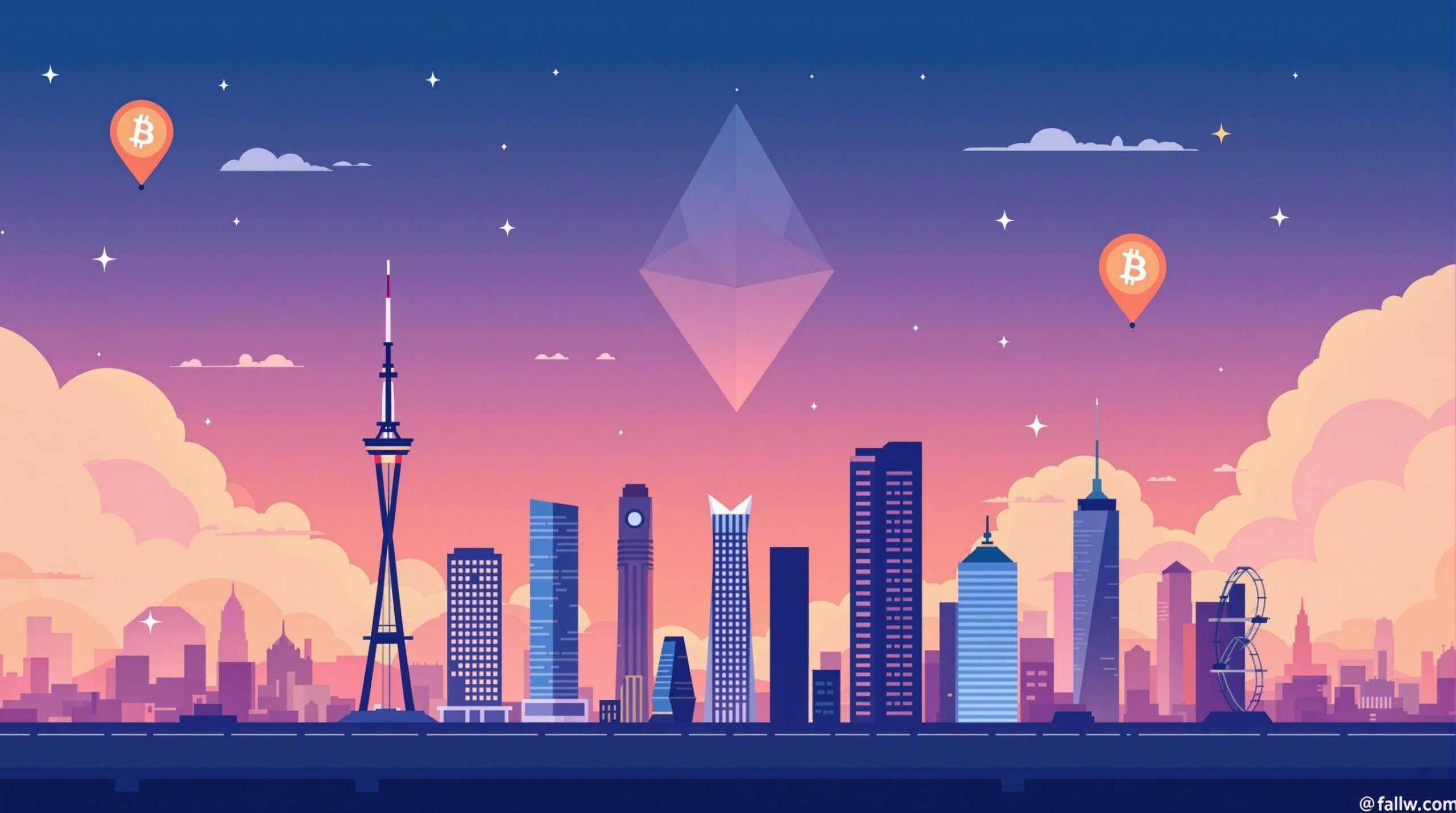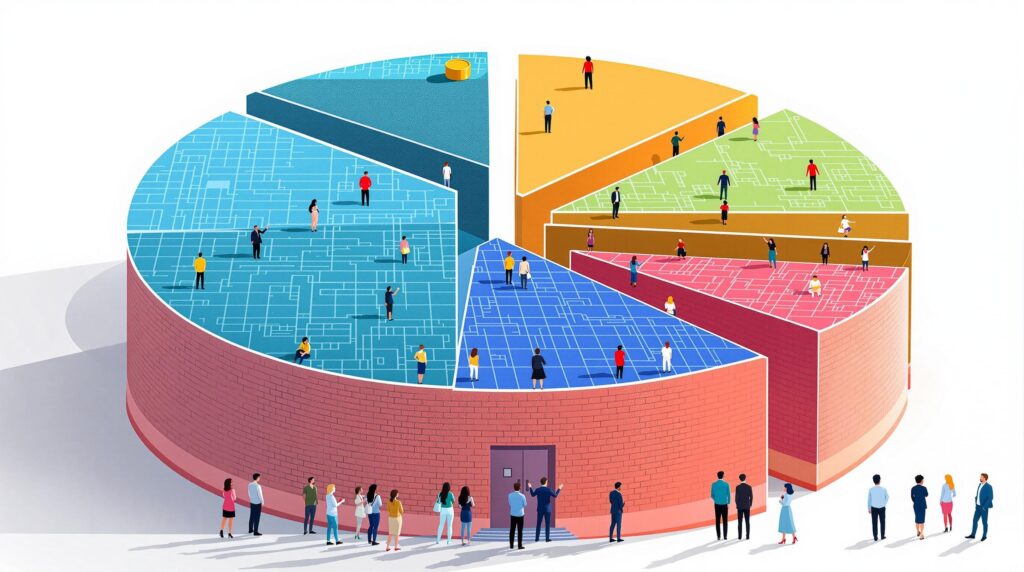[rev_slider alias=”slider-1″][/rev_slider]
Understanding Layer 1 Blockchains for Smart Contracts and dApps
Layer 1 blockchains form the backbone of the cryptocurrency and blockchain sectors. But what exactly are they, and why are they so crucial? Imagine a highway system. In this analogy, Layer 1 blockchains are the main highways that allow vehicles (transactions) to move efficiently from one point to another. They provide the fundamental architecture that supports all operations, enabling seamless interactions and transactions across the network.
What are Layer 1 blockchains? Layer 1 blockchains are the foundational networks that underlie smart contracts and decentralized applications (dApps), providing essential services like security, transaction processing, and consensus.
The primary role of Layer 1 blockchains in the blockchain universe is to offer a secure and decentralized environment where smart contracts and dApps can operate smoothly. These blockchains maintain the integrity and validity of transactions through consensus mechanisms like Proof of Work (PoW) and Proof of Stake (PoS).
The Significance of Layer 1 in the Blockchain Ecosystem
Layer 1 blockchains such as Ethereum, Bitcoin, and Binance Smart Chain each play a unique role in the ecosystem. Let’s dive into these examples to better understand their significance:
- Ethereum: Known for its robust smart contract capabilities, Ethereum is a pioneer in creating a decentralized environment where applications run without any chance of fraud, downtime, or third-party interference.
- Bitcoin: Primarily recognized as a peer-to-peer digital currency, Bitcoin’s blockchain maintains impeccable security and decentralization through its PoW mechanism, though it’s not typically used for hosting smart contracts.
- Binance Smart Chain (BSC): As an alternative to Ethereum, BSC provides faster transaction speeds and lower fees, making it an attractive choice for developers of dApps who need efficient performance and scalability.
Each of these platforms offers unique features that cater to specific blockchain needs within the digital economy. Ethereum, for instance, brought smart contracts to the forefront, empowering a new generation of dApps. Meanwhile, BSC offers enhanced efficiency and cost-effectiveness, essential for burgeoning markets such as Africa’s digital asset economy.
Layer 1 Blockchain Features and Functionalities
Understanding the core functionalities of Layer 1 blockchains is key to grasping their global impact. Here are some primary features they bring to the table:
- Security: The decentralized nature ensures that no single entity can alter the data, making fraud extremely difficult.
- Consensus: Through mechanisms like PoW and PoS, they validate transactions and ensure all participants agree on the ledger’s state.
- Scalability: Layer 1 solutions are continuously evolving to handle more transactions, albeit sometimes facing bottlenecks that lead to the development of Layer 2 solutions.
These components are crucial to their operation and necessitate constant adaptation to accommodate the growing demands of blockchain technology in areas such as Africa, where economic shifts are prominent.
The Role of Layer 1 in Supporting Smart Contracts and dApps
Smart contracts and dApps are essentially the applications running on these highways. They utilize the network’s capabilities to execute predefined actions without the need for intermediaries. Let’s explain this using an everyday analogy: think of a smart contract as a vending machine. Once you input money and a product code, the machine automatically vends your selection without needing human intervention. Similarly, smart contracts execute commands based on predetermined conditions, providing efficiency and transparency.
How do Layer 1 blockchains support smart contracts? Layer 1 blockchains facilitate the creation, execution, and validation of smart contracts, enabling autonomous and tamper-proof transactions across decentralized applications.
The ability to host and process smart contracts makes Layer 1 blockchains indispensable for digital asset ecosystems such as Jara. By leveraging a proprietary Layer 2 blockchain that is Caldera-based, Jara ensures fast and secure transactions, essential for its vast network of tokenized assets and dApps. This approach is pivotal as Africa unlocks a potential $200 billion digital asset economy with Jara’s unique platform.
Conclusion
Layer 1 blockchains are a cornerstone of modern blockchain technology, enabling a wide range of functionalities from smart contracts to encompassing decentralized applications. By understanding their significance and capabilities, investors and tech enthusiasts can appreciate the role they play, particularly in rapidly evolving markets like Africa, where platforms like Jara aim to bridge global capital to the continent’s robust assets.
Exploring Layer 2 Solutions
As blockchain technology evolves, Layer 1 blockchains face significant challenges in scalability and efficiency. Let’s dive into how Layer 2 solutions are addressing these issues to enhance performance and user experience.
Layer 1 blockchains, like Bitcoin and Ethereum, are the foundational networks that handle all the transactions directly. However, as the number of users increases, these blockchains often struggle with slower transaction speeds and higher fees. This is akin to a busy highway during rush hour, where increased traffic slows everything down. So, how do we overcome these bottlenecks?
Enter Layer 2 solutions. These are secondary networks that operate on top of existing blockchains, designed to improve scalability without compromising security or decentralization. Think of them as express lanes on a highway, diverting some traffic to maintain a smooth flow.
Technologies Behind Layer 2 Solutions
- Sidechains: These are separate blockchains running parallel to the main blockchain. They allow transactions to occur independently while occasionally interacting with the main chain, optimizing speed and reducing costs. A significant example is Polygon, which enhances Ethereum’s scalability.
- Off-Chain Computation: This process involves moving transactions off the main blockchain, executing them off-chain, and then recording the results back on the main chain. This is like using a cake pre-mix: you do all the mixing in a separate bowl, then bake it in the main oven.
- State Channels: These channels facilitate two-way communication between participants, allowing them to process multiple transactions off-chain before finalizing them on the blockchain. This reduces the need for processing each transaction individually on the main chain.
Layer 2 solutions like sidechains and off-chain computation reduce congestion and enhance speed, offering seamless scalability for blockchains.
Impact on Scalability and Transaction Speeds
The impact of Layer 2 solutions on scalability and transaction speeds cannot be overstated. With mechanisms like sidechains and off-chain solutions, blockchains can process thousands of transactions per second without being hindered by the main chain’s limitations. This is revolutionary, especially in regions like Africa, where digital financial solutions can significantly foster economic growth and financial inclusion.
One notable example is the Lightning Network, a Layer 2 protocol for Bitcoin that enables fast transactions without compromising security. By using smart contracts, it opens numerous channels between users, allowing quick and cost-effective Bitcoin transactions.
The Lightning Network for Bitcoin exemplifies how Layer 2 solutions enhance scalability, making high-speed transactions over blockchain possible.
Real-World Applications and Examples
Beyond transaction speed, the practical applications of Layer 2 solutions are vast. For instance, Jara utilizes its proprietary Layer 2 blockchain for the seamless integration of digital assets within Kenya’s financial landscape. As highlighted in various cryptocurrency initiatives, these enhancements empower businesses and users to interact with blockchain technology more efficiently.
By adopting these technologies, platforms can significantly reduce transaction fees, making digital assets more accessible to a broader audience. This not only boosts user engagement but also encourages more developers to create dApps and other blockchain-based solutions, pushing the industry further into a digitally inclusive future.
Layer 2 solutions not only improve blockchain scalability but also democratize access to digital assets, fostering innovation and economic growth.
[rev_slider alias=”text-call-cta”][/rev_slider]
Comparing Leading Layer 1 Blockchain Protocols
Key Features of Top Blockchains
When diving into the world of Layer 1 blockchains, the distinct features of each protocol play a crucial role in determining their suitability for various decentralized applications (dApps) and smart contracts. Let’s explore the key characteristics of leading blockchain technologies such as Ethereum, Bitcoin, and Solana, emphasizing how their unique attributes can benefit developers and users alike.
- Ethereum’s Smart Contract Capabilities: Ethereum remains at the forefront of blockchain innovation due to its robust smart contract functionalities. These are programmable scripts that automatically execute actions when certain conditions are met, forming the backbone of various applications like DeFi platforms, NFTs, and decentralized exchanges.
- Bitcoin’s Security Features: Known primarily for its unrivaled security, Bitcoin’s proof-of-work consensus mechanism ensures transaction integrity and network security. This makes it an ideal choice for applications where security and trust are paramount.
- Solana’s High Throughput: Solana offers one of the highest transaction throughputs among Layer 1 blockchains, capable of handling thousands of transactions per second. This efficiency is particularly advantageous for dApps requiring quick processing times and scalability, such as gaming and high-frequency trading platforms.
Why are Layer 1 blockchains crucial for dApp development? Layer 1 blockchains serve as the foundational network layer providing basic functions like consensus and storage, enabling developers to build diverse applications directly on their architecture.
This comparison clearly highlights each protocol’s strengths, aiding in the selection of the most suitable blockchain for specific use cases. With Africa’s burgeoning digital economy, choosing the right blockchain for your project can significantly impact its success by leveraging the appropriate features offered by these pioneering networks.
Why choose Jara for your African blockchain projects? With the $JARA token, investors not only tap into a $200B+ digital asset economy but also benefit from Jara’s proprietary Layer 2 blockchain, designed to enhance speed and efficiency for a seamless development experience.
Whether it’s Ethereum’s flexibility, Bitcoin’s security, or Solana’s scalability, the choice of blockchain involves strategic considerations based on the intended application. As Africa continues its digital revolution, platforms like Jara are essential for bridging global capital to African ventures, providing powerful tools for economic empowerment. For instance, Jara’s involvement in tokenizing real-world assets such as the Lagos airport project exemplifies the potential of innovative blockchain solutions in transforming traditional industries.
Future Trends: Layer 1 and Layer 2 Integration
As we dive into the future of blockchain technology, the integration of Layer 1 and Layer 2 solutions emerges as a pivotal development. But what does this integration really mean for the blockchain ecosystem? Let’s break it down to better understand how these advancements are reshaping various sectors.
What is Layer 1 and Layer 2 integration in blockchain? Layer 1 and Layer 2 integration refers to the coordination between foundational blockchain protocols (Layer 1) and added technologies (Layer 2) to enhance scalability, functionality, and efficiency in blockchain networks.
Incorporating Layer 2 onto existing Layer 1 blockchains allows for increased scalability and efficiency. Think of Layer 1 as the main highway and Layer 2 as auxiliary roads that help reduce congestion — allowing for faster movement of information and reducing the workload on the main routes. This design is crucial for achieving higher transaction speeds and lower costs, which is beneficial for mass adoption of blockchain technology.
Innovations on the Horizon
As Layer 1 and Layer 2 solutions become more integrated, we expect some exciting innovations. One such trend is the development of rollups, which help manage transactions off-chain while maintaining the security of the main blockchain. Similarly, sidechains and cross-chain technology are also becoming key players, allowing different blockchains to interact seamlessly, thereby enhancing the overall efficiency of decentralized applications (dApps).
Industries such as finance, gaming, and supply chain are poised to benefit tremendously from Layer 1 and Layer 2 integration, driving forward the blockchain revolution.
Impact on Smart Contracts and dApps
The integration of Layer 1 and Layer 2 solutions is set to revolutionize smart contracts and dApps by providing the technological infrastructure needed for complex computations and large-scale transactions. By utilizing these advancements, developers can create more sophisticated applications that are sustainable and user-friendly. Imagine smarter, faster gaming platforms where players can trade assets in real-time without network lag, or financial services that offer instantaneous transactions with minimal fees — the possibilities are endless.
Benefiting Industries
- Finance: The financial industry is set to witness a transformative impact, with blockchain enabling quicker, more secure settlements, reduced transaction costs, and improved cross-border payments.
- Gaming: In gaming, the integration will allow for decentralized game economies where in-game assets can be seamlessly traded or sold, enhancing player experiences.
- Supply Chain: Supply chains will benefit from improved transparency and traceability, allowing companies to track products from origin to delivery with precision.
Overall, the integration of Layer 1 and Layer 2 solutions is akin to equipping the blockchain world with turbo engines, speeding up the adoption of smart contracts and dApps while opening up numerous opportunities across different industries. As Africa’s digital landscape continues to evolve, the role of innovative technologies such as these becomes increasingly critical, paving the way for future prosperity.
[rev_slider alias=”schedule-consultation-btn”][/rev_slider]

What are the advantages of Layer 1 blockchains for dApps?
Layer 1 blockchains offer several advantages for developing decentralized applications (dApps). They provide a secure and decentralized infrastructure that enhances the robustness and immutability of transactions and smart contracts. Key benefits include improved security, increased data integrity, and wide-ranging interoperability for a multitude of dApps.
How does a Layer 2 solution improve blockchain scalability?
Layer 2 solutions improve blockchain scalability by offloading data processing onto a secondary layer, thereby reducing the strain on the main blockchain, or Layer 1. This separation allows for faster transaction processing and reduced congestion, enhancing the overall efficiency of blockchain networks by leveraging technologies such as rollups or sidechains.
Can Layer 1 and Layer 2 blockchains work together?
Yes, Layer 1 and Layer 2 blockchains can work together to improve the performance and scalability of blockchain networks. Layer 1 provides the base level of security and decentralization, while Layer 2 offers enhanced transaction speeds and scalability by processing transactions off-chain. This synergy allows for scalable dApp development while maintaining core blockchain principles.
What role does Jara play in Africa’s digital economy?
Jara, by providing a proprietary Layer 2 blockchain infrastructure, plays a crucial role in advancing Africa’s digital economy. It enhances the accessibility and efficiency of financial services across the continent. The $JARA token also fuels this ecosystem, offering robust opportunities for governance, rewards, and investment in tokenized real-world assets, thus fostering economic empowerment and financial inclusion in Africa.

Related Pages for Layer 1 Blockchains and dApps
If you’re interested in learning more about related areas, check out these additional pages that delve into various aspects of blockchain technology and its applications.
Hear From Our Satisfied Blockchain Clients in Africa
At the forefront of our Layer 1 and Layer 2 blockchain solutions practice, we prioritize client satisfaction. Each project is managed with utmost dedication, as echoed in the positive feedback we receive.

[rev_slider alias=”slider-3″][/rev_slider]
[rev_slider alias=”slider-6″][/rev_slider]
Your Gateway to Cutting-Edge Blockchain Solutions
Embark on your journey in the evolving world of blockchain with Jara. Our expertise in Layer 1 and Layer 2 solutions ensures that you have access to top-tier blockchain innovations tailored to your needs. Discover how we bridge global capital to African assets, transforming potential into tangible results. Don’t just take our word for it, explore our accolades below:
“Your Gateway to Transformative Blockchain Solutions.”
| Award | Granting Organization | Year | Criteria |
|---|---|---|---|
| Innovative Blockchain Solution | Blockchain Excellence Awards | 2023 | Recognized for groundbreaking Layer 1 solutions |
| Top Financial Technology Innovators | FinTech Innovators Council | 2023 | Featured among leaders leveraging blockchain in finance |
| Leaders in dApps Development | Global dApps Awards | 2023 | Highlighted for advancements in decentralized protocols |
| Best in Blockchain Integration | Tech Integration Council | 2023 | Listed among the best for seamless Layer 1 and 2 integration |
| Pioneers in Cryptocurrency Horizons | Crypto Future Summit | 2023 | Acknowledged for expanding blockchain horizons |
Ready to redefine your blockchain future? Join us and experience unparalleled service tailored just for you. Download the Jara app on Android or iPhone today. Connect with us at [email protected].
Chinyere “Chi” Nnadi Bio
Founder and CEO, Jara | Blockchain Innovator and Specialist
Content Reviewed by Chi Nnadi and his Content Team. Chi is an experienced entrepreneur dedicated to transforming Africa’s financial ecosystem through blockchain technology. As Founder and CEO of Jara, he pioneers enterprise-grade infrastructure converting illiquid African assets into globally accessible digital tokens. With his proprietary Layer-2 blockchain technology, Chi bridges the gap between global investors and Africa’s growing digital asset market.
Our Content Review Process
Chi Nnadi along with Jara’s dedicated content team, pledge to offer top-notch material. Our content guidelines ensure thoroughness, reputable sources, unbiased scrutiny, among other quality metrics. Please let us know if there is anything you believe to be inaccurate.
















